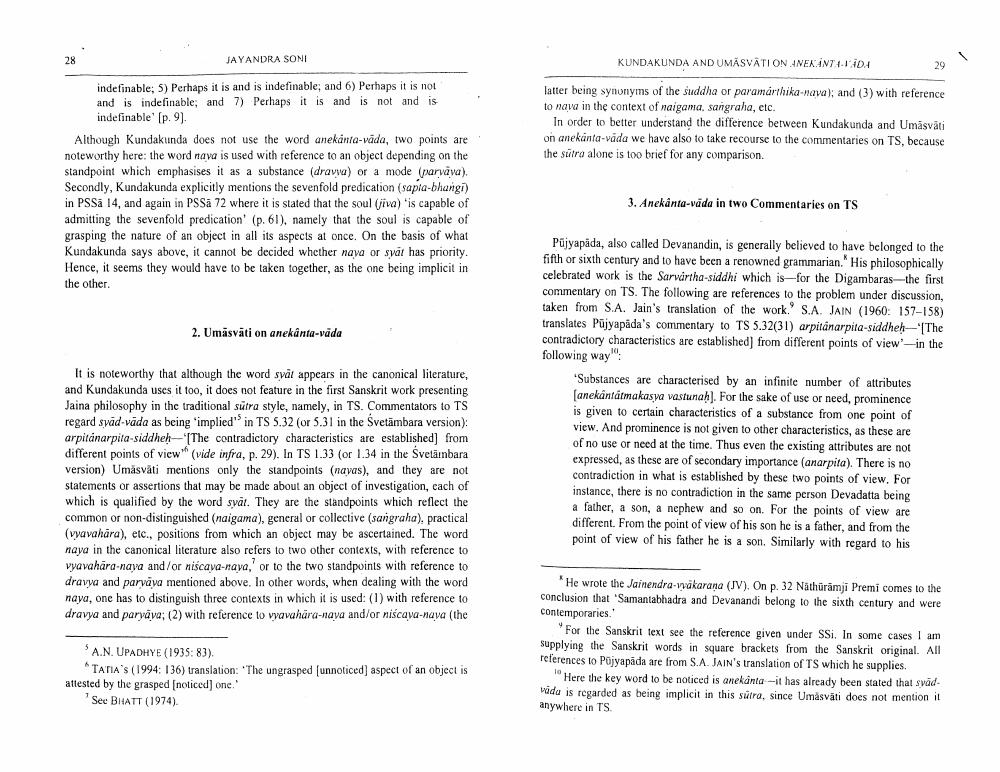________________
JAYANDRA SONI
KUNDAKUNDA AND UMĀSVĀTION INEKANTA-LADA
latter being synonyms of the suddha or paramarthika nava); and (3) with reference to nava in the context of naigana, sangraha, etc.
In order to better understand the difference between Kundakunda and Umásvāti on anekanta-vada we have also to take recourse to the commentaries on TS, because the sülra alone is too brief for any comparison.
indetinable; 5) Perhaps it is and is indefinable; and 6) Perhaps it is not and is indefinable; and 7) Perhaps it is and is not and is
indefinable' (p. 9). Although Kundakunda does not use the word anekanta-vāda, two points are noteworthy here: the word nava is used with reference to an object depending on the standpoint which emphasises it as a substance (drava) or a mode (parvava). Secondly, Kundakunda explicitly mentions the sevenfold predication (sapla-bhangi) in PSS 14, and again in PSSa 72 where it is stated that the soul (jiva) 'is capable of admitting the sevenfold predication' (p. 61), namely that the soul is capable of grasping the nature of an object in all its aspects at once. On the basis of what Kundakunda says above, it cannot be decided whether nava or spat has priority. Hence, it seems they would have to be taken together, as the one being implicit in the other.
3. Anekanta-vada in two Commentaries on TS
2. Umāsvāti on anekanta-vada
It is noteworthy that although the word svat appears in the canonical literature, and Kundakunda uses it too, it does not feature in the first Sanskrit work presenting Jaina philosophy in the traditional sutra style, namely, in TS. Commentators to TS regard spád-vada as being 'implied in TS 5.32 (or 5.31 in the Svetämbara version) arpitánarpila-siddheh--[The contradictory characteristics are established) from different points of view (vide infra, p. 29). In TS 1.33 (or 1.34 in the Svetärbara version) Umasvati mentions only the standpoints (nayas), and they are not statements or assertions that may be made about an object of investigation, cach of which is qualified by the word spāt. They are the standpoints which reflect the common or non-distinguished (naigama), general or collective (sangraha), practical (vyavahāra), etc., positions from which an object may be ascertained. The word naya in the canonical literature also refers to two other contexts, with reference to vyavahāra-naya and/or niscaya-nava, or to the two standpoints with reference to dravya and parvava mentioned above. In other words, when dealing with the word naya, one has to distinguish three contexts in which it is used: (1) with reference to dravya and paryaya; (2) with reference to vyavahāra-naya and/or niscaya-nava (the
Pujyapada, also called Devanandin, is generally believed to have belonged to the fifth or sixth century and to have been a renowned grammarian. His philosophically celebrated work is the Sarwartha-siddhi which is for the Digambaras the first commentary on TS. The following are references to the problem under discussion, taken from S.A. Jain's translation of the work. S.A. JAIN (1960: 157-158) translates Pujyapada's commentary to TS 5.32(31) arpitánarpita-siddheh--The contradictory characteristics are established) from different points of view'-in the following way":
'Substances are characterised by an infinite number of attributes [anekantármakasya vastunah). For the sake of use or need, prominence is given to certain characteristics of a substance from one point of view. And prominence is not given to other characteristics, as these are of no use or need at the time. Thus even the existing attributes are not expressed, as these are of secondary importance (anarpita). There is no contradiction in what is established by these two points of view. For instance, there is no contradiction in the same person Devadatta being a father, a son, a nephew and so on. For the points of view are different. From the point of view of his son he is a father, and from the point of view of his father he is a son. Similarly with regard to his
A.N. UPADHYE (1935: 83).
TATIA's (1994: 136) translation: The ungrasped unnoticed) aspect of an object is attested by the grasped (noticed) one."
See BHATT (1974)
He wrote the Jainendra-nakarana (JV). On p. 32 Nathūrāmji Premi comes to the conclusion that 'Samantabhadra and Devanandi belong to the sixth century and were contemporaries.
For the Sanskrit text see the reference given under SSi. In some cases I am supplying the Sanskrit words in square brackets from the Sanskrit original. All references to Pujyapada are from S.A. JAIN's translation of TS which he supplies.
"Here the key word to be noticed is anekanta -it has already been stated that svádwida is regarded as being implicit in this súlra, since Umasväti does not mention il anywhere in TS




